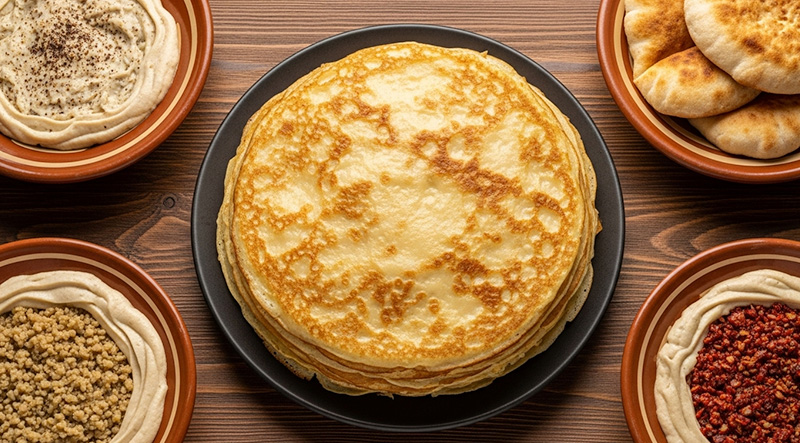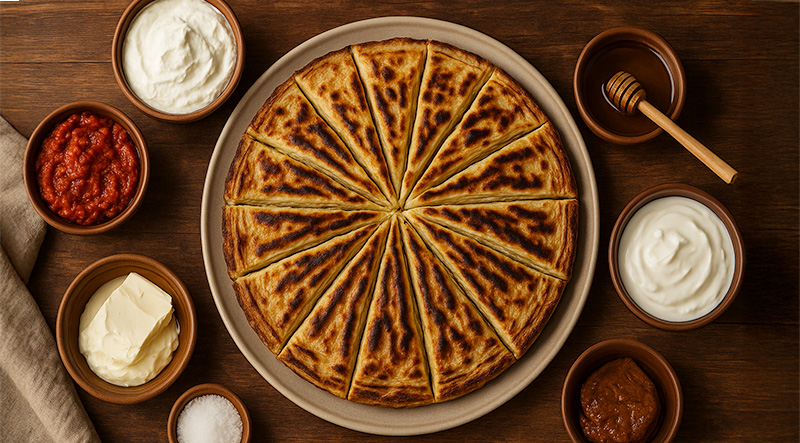Flija, a genuine work of love and the pride of Kosovo's kitchen, is golden, crispy, and full of tradition. This savory pie, which is as fascinating to make as it is to eat, is made from delicate layers of batter that are brushed with creamy kaymak or butter and cooked one stripe at a time under a hot metal dome. Flija is more than just food; it's a ceremonial centerpiece that's served at weddings, family get-togethers, and holidays all over the nation because of its smoky aroma, chewy-crisp texture, and rustic charm. You can taste the warmth of Kosovar hospitality in every bite of this multi-layered masterpiece. Read More...
The History of Kosovo’s National Dish – Flija:
In the heart of the Balkans, nestled among mountains and meadows, one dish stands out as a symbol of tradition, patience, and family: Flija. This uniquely layered pastry—made with flour, water, and love—is Kosovo’s most iconic dish and a culinary tradition passed down through generations. With its golden, striped surface and smoky aroma, Flija isn’t just food—it’s an art form and cultural ritual, representing the resilience and warmth of the Kosovar people.
What is Flija?
Flija (pronounced flee-yah) is a savory dish made by alternating layers of thin batter—consisting mainly of flour, water, and a pinch of salt—with generous brushings of kaymak (a creamy dairy spread) or butter. Each layer is poured into a circular pan and cooked one stripe at a time using a traditional saç, a round metal lid covered in embers and placed over the dish to bake it slowly. The process takes time—often over two hours—as each strip is individually cooked before the next is poured in.
Flija is typically served in pie-like wedges, accompanied by yogurt, honey, or traditional spreads like ajvar. Its texture combines the crispness of roasted batter with the softness of its layered center, making it both rustic and indulgent.
Origins in the Hearth:
Flija’s roots are deeply embedded in Kosovo’s rural traditions, especially in mountainous regions where self-sufficiency and hospitality are central to daily life. Historically, it was made by women in village homes using open fires or stone ovens, with the saç being the primary cooking method long before modern ovens were available.
More than a dish, Flija was often a ritual and communal activity—the preparation required time and teamwork, often involving several family members. It was reserved for special occasions such as weddings, births, family reunions, and religious holidays like Bajram. Its slow cooking process naturally brought people together, encouraging storytelling, laughter, and shared effort.
A Symbol of Hospitality and Celebration:
In Kosovar culture, Flija represents generosity, patience, and care. It is often prepared when guests visit or when families gather for Sunday lunch. Because of the time and attention it requires, making Flija is considered a gesture of honor and affection—a dish not just made to feed, but to welcome.
In some regions, the dish is also associated with agricultural traditions and was believed to bring good fortune when made at the start of the planting season or shared during harvest.
Flija Across the Balkans:
While Flija is most closely associated with Kosovo and northern Albania, similar versions exist in neighboring Balkan countries like Montenegro and North Macedonia, each with slight variations in ingredients or presentation. However, Kosovo remains its cultural home, where the dish continues to thrive as both a beloved comfort food and a heritage meal.
Today, Flija is featured in restaurants, food festivals, and diaspora communities, where it serves as a symbol of identity and nostalgia for Kosovars abroad.
Flija Today: A Living Tradition:
Despite the pressures of modernization and fast food, Flija holds strong. In both city homes and country kitchens, families still take pride in the traditional way of making it—sometimes using modern ovens but often preserving the old ways with wood fires and saç domes.
As younger generations reclaim traditional cooking, Flija has experienced a revival not just in Kosovo but in international food culture as well, thanks to food bloggers, chefs, and cultural exhibitions.
More Than a Meal:
Flija is more than Kosovo’s national dish—it is a testament to heritage, endurance, and unity. With every stripe carefully poured and every bite steeped in memory, it tells a story of a people who value time, tradition, and the joy of coming together.
Whether prepared for a guest, a family gathering, or a feast, Flija is Kosovo on a plate: warm, welcoming, and layered with love.
Prepare the Batter:
Prepare the Kaymak Mixture:

Prepare the Cooking Setup:
Begin the Layering Process:
This process takes 1.5 to 2 hours, as each strip must cook before the next is added.

Final Bake (Optional):
Rest and Serve:

Tips:
The total preparation and cooking time for traditional Flija is approximately 2 to 2.5 hours. Mixing the simple batter of flour, water, and salt takes about 10–15 minutes, and preparing the kaymak-butter mixture adds another 5 minutes. The most time-consuming part is the layered cooking process, where each stripe of batter is individually poured, cooked under a broiler or traditional saç, and brushed with fat—this layering and baking cycle takes 1.5 to 2 hours, depending on the heat source and pan size. Once complete, Flija is typically rested for 10 minutes before serving, making it a slow-cooked dish that rewards patience with rich, traditional flavor.
A single serving of Flija, based on the traditional recipe provided, contains approximately 400–600 calories, depending on the size of the slice and the amount of butter or kaymak used. The flour-based batter contributes most of the carbohydrates, averaging around 200–250 calories per serving, while the kaymak or butter mixture layered between stripes adds another 150–300 calories due to its high fat content. Optional toppings like yogurt or honey can increase the total by 50–100 calories. Because Flija is dense, rich, and layered with fat, it’s a filling and energy-rich dish typically enjoyed in moderation as part of a festive meal.







